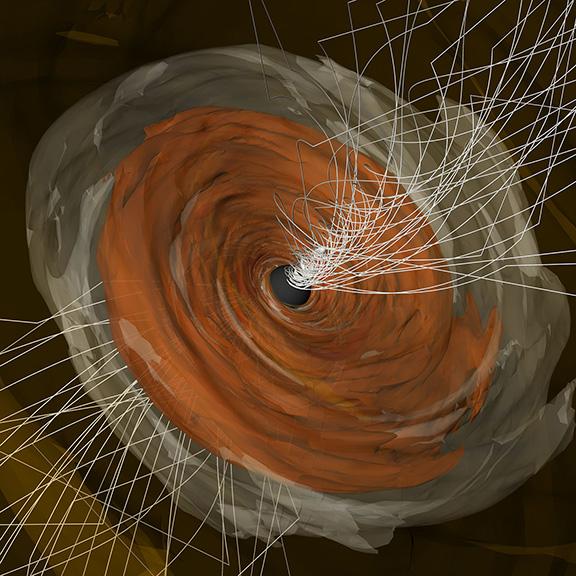A Supermassive Black Hole’s Strong Magnetic Fields Are Revealed in a New Light
The Event Horizon Telescope (EHT) collaboration has published new results in a pair of papers describing for the first time how light from the edge of the supermassive black hole M87* spirals as it escapes the black hole’s intense gravity. This work confirms that the magnetic fields near the black hole are so strong that they push back on infalling matter and help launch jets at velocities near the speed of light.

Cambridge, MA -- In 2019, the EHT released its first image of a ring of hot plasma close to the event horizon of M87*. In 2021, EHT produced new images in polarized light, giving the first sign that the magnetic fields close to the black hole were strong. The measurements reported today demonstrate the presence of spiraling light – or circular polarization – providing more conclusive evidence for these strong magnetic fields.
The two papers describing these results have just been published in The Astrophysical Journal Letters. One of the papers was led by Freek Roelofs, a postdoctoral fellow at the Smithsonian Astrophysical Observatory (SAO), a part of the Center for Astrophysics | Harvard & Smithsonian (CfA). The other paper is by the Event Horizon Telescope Collaboration.
Roelofs' analysis revealed a surprising asymmetry across the image, which is only visible in spiraling light. "If this asymmetry persists and is confirmed with future, better datasets, it may teach us about the characteristics of the magnetic fields and plasma near the black hole," Roelofs said. "Working together to see what we can and cannot squeeze out of our data has made this project incredibly exciting and rewarding."
"Circular polarization is the final signal we looked for in the EHT's first observations of the M87 black hole, and it was by far the hardest to analyze," adds former CfA member and EHT polarization project coordinator Andrew Chael, who is currently an associate research scholar at the Gravity Initiative at Princeton University.
"The signal in circular polarization is 100 times weaker than the unpolarized data we used to make the first black hole image," says Ioannis Myserlis, a staff astronomer at the Institut de Radioastronomie Millimétrique (IRAM). "Finding this weak signal in the data was like trying to listen to a conversation next to a jackhammer. We had to carefully test our methods to determine what we could really trust."
The team used these observations to test different theories for the motion of plasma and magnetic field around the black hole, including a set of state-of-the art supercomputer simulations. "The circular polarization observations bolster our confidence that the magnetic fields are strong enough to push back on the infalling matter and help launch the strong jets of plasma we see extending throughout the M87 galaxy," said Angelo Ricarte, a postdoctoral fellow at the CfA and a Fellow at the Harvard Black Hole Initiative. Abhishek Joshi, a graduate student at the University of Illinois, added, "It's wonderful to directly compare our simulations to these cutting-edge observations. Together, they paint a picture of a chaotic, violent environment just outside the event horizon, where magnetic fields, gravity, and hot plasma strongly interact with each other."
"Working with these pioneering observations was really challenging, but it trained us well for the future," said Svetlana Jorstad, a senior research scientist at Boston University. "The EHT is growing rapidly, with new telescopes and better technology at all our sites, giving us a more sensitive and detailed set of data to work with. It's exciting to contemplate how much better our results could get in just a short time."
###
About the Event Horizon Telescope (EHT)
The EHT consortium consists of 13 stakeholder institutes; the Academia Sinica Institute of Astronomy and Astrophysics, the University of Arizona, the University of Chicago, the East Asian Observatory, Goethe-Universitaet Frankfurt, Institut de Radioastronomie Millimétrique, Large Millimeter Telescope, Max Planck Institute for Radio Astronomy, MIT Haystack Observatory, National Astronomical Observatory of Japan, Perimeter Institute for Theoretical Physics, Radboud University and the Center for Astrophysics | Harvard & Smithsonian.
About the Center for Astrophysics | Harvard & Smithsonian
The Center for Astrophysics | Harvard & Smithsonian is a collaboration between Harvard and the Smithsonian designed to ask—and ultimately answer—humanity's greatest unresolved questions about the nature of the universe. The Center for Astrophysics is headquartered in Cambridge, MA, with research facilities across the U.S. and around the world.
Media Contact:
Amy C. Oliver, FRAS
CfA Public Affairs Officer, Fred Lawrence Whipple Observatory
Center for Astrophysics | Harvard & Smithsonian
amy.oliver@cfa.harvard.edu
Related News
NASA's Hubble, Chandra Find Supermassive Black Hole Duo
Event Horizon Telescope Makes Highest-Resolution Black Hole Detections from Earth
CfA Celebrates 25 Years with the Chandra X-ray Observatory
CfA Astronomers Help Find Most Distant Galaxy Using James Webb Space Telescope
Astronomers Unveil Strong Magnetic Fields Spiraling at the Edge of Milky Way’s Central Black Hole
Black Hole Fashions Stellar Beads on a String
M87* One Year Later: Proof of a Persistent Black Hole Shadow
Unexpectedly Massive Black Holes Dominate Small Galaxies in the Distant Universe
Unveiling Black Hole Spins Using Polarized Radio Glasses
NASA Telescopes Discover Record-Breaking Black Hole
Projects
AstroAI
DASCH (Digital Access to a Sky Century @ Harvard)
For that reason, the DASCH (Digital Access to a Sky Century @ Harvard) team are working to digitize the plates for digital storage and analysis. The process can also lead to new discoveries in old images, particularly of events that change over time, such as variable stars, novas, or black hole flares.
GMACS
For Scientists
Sensing the Dynamic Universe
SDU Website